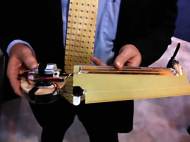Lockheed Martin’s Samarai Micro Air Vehicle inspired by maple seed
 Most of us had the opportunity to play with maple seed and observe it spiraling down after we throw it. Several groups of engineers around the world have been inspired by maple seed and applied biomimicry to construct small flying machines. Lockheed Martin came up with Samarai which was exhibited at the Association for Unmanned Vehicle Systems International conference.
Most of us had the opportunity to play with maple seed and observe it spiraling down after we throw it. Several groups of engineers around the world have been inspired by maple seed and applied biomimicry to construct small flying machines. Lockheed Martin came up with Samarai which was exhibited at the Association for Unmanned Vehicle Systems International conference.
Samarai is 40.6 cm (16 inches) long and it weights less than quarter of a kilogram (half a pound). It is mechanically simple with only two moving parts. The vehicle was produced by 3D printing where successive small layers of plastic are “printed” to create a single form. The printer eliminates expensive production costs, allowing engineers to quickly and affordably produce Samarai tailored to specific missions.
“Our team has taken the basic shape and design of the naturally aerodynamic maple seed and harnessed it with flight controls and avionics”, said Kingsley Fregene, principal investigator for Samarai at Lockheed Martin’s Advanced Technology Laboratories. “We’ve learned a great deal about biologically inspired vehicles that we can apply across the laboratory, including a better understanding of micro-robots and the devices that control their movement.”
A currently unique feature Samarai offers is an onboard video camera that transmits a live feed to the operator who can control it by remote control or by an app on smart device. It is capable to provide aa virtual 360 view of its surroundings and you can choose to observe 90 degrees on a relatively steady stream of video.
Since Samarai rotates around an axis in its flight, the onboard video camera captures one frame at the same point in every rotation. The imaging software is able to clear and stabilize the picture, but it still appears a bit fuzzy when it comes to small details. Future advancement of imaging technology and algorithms should solve that problem.
When you fly such a vehicle relying solely on a relatively steady image, you are bound to make it collide with its surroundings. In order to counter that, its developers came up with two solutions. The first collision detection that they tried to implement is an ultrasonic source mounted onto the platform and it relies on the Doppler effect produced by the rotation of the vehicle to sense range. The second collision detection system is simpler and it is an adjustable “proximity sensor” which uses an optical flow technique similar to that used by insects to avoid collision.
At the Association for Unmanned Vehicle Systems International conference Samarai demonstrated vertical takeoff and landing, stable hover, and on-board video streaming. While the aircraft flew a series of flights in the roughly 40 foot test area, it streamed live video from a camera that rotated around its center providing a 360 degree view without a gimbal.
Samarai’s size and weight enable its operator to easily carry the vehicle in a backpack and launch it from the ground or like a boomerang. The design is scalable to meet different missions, including surveillance and reconnaissance and payload delivery.









Excellent case of biomimicking. Nature offers many solutions to complex problems.
Dr.A.Jagadeesh Nellore(AP),India
E-mail: anumakonda.jagadeesh@gmail.com